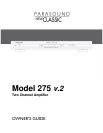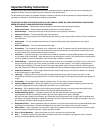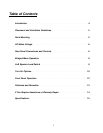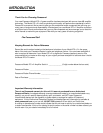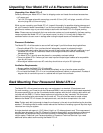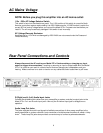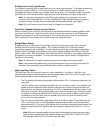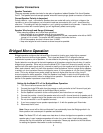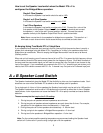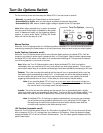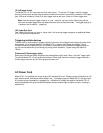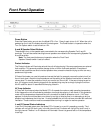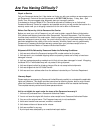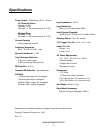7
R (Right) and L (Left) Level Knobs
To increase the listening level for each channel turn its Level knob clockwise. To decrease the listening
level turn it counter-clockwise. The 275 has a total gain of 28 dB so that its volume levels are
compatible with other channels in your theater if they are driven by a THX-certified amplifier, up to the
point where the THX-certified amplifier might play a bit louder because of its higher power output.
Note: You may wish to experiment with different gain settings on your preamp or surround
controller and on the Model 275 v.2 to find a combination of gain settings where your system’s
background noise is lowest. Sound professionals call these adjustments ―gain staging.‖
Note: Only the R channel Level knob is used for bridged mono operation.
Front Panel Speaker Selector Lockout Switch
When this switch is set to Normal, the front panel A and B buttons determine whether speaker output
terminals A and B are live. When this switch is set to Lockout, the front panel A and B buttons are
disabled and speakers A and B will always be on. This can be particularly useful for a professional
audio installer who never intends for the client to use the front panel buttons.
Bridged Mono Switch
Bridged operation configures the Left and Right channels to function as a single higher powered
amplifier channel to drive a single speaker. This is how two Model 275 v.2 amps are used as
monoblocks to power a pair of speakers. It’s also effective for powering a single passive subwoofer.
Please note that in bridged mono operation the minimum speaker impedance is 8 Ohms (if the load
switch is set to 4-8Ω). With the Speaker Load switch set to the 2-3Ω position it is possible to drive two
8Ω speakers or a single 4Ω speaker. For more information please see the section on Bridged Mono
Operation in this manual.
Note: The Model 275 v.2 power should always be turned off before moving this switch.
Note: If two speakers are attached for normal stereo operation the sound will be faint and very
distorted if you accidentally leave the Bridged Mono switch in its Mono position.
High Pass Filter Switch
The High Pass Filter can improve the sound in many installations. It’s called a ―high pass‖ filter
because depending on the switch position it permits signals higher than 20 Hz or 40 Hz to pass, while
preventing signals below these frequencies from passing.
• The Flat setting of this switch disconnects the filter and the 275 v.2’s frequency response is full
range (flat).
• The 20 Hz setting filters out frequencies below 20 Hz at 18 dB per octave. Your speakers have
greater dynamic range and far less distortion when they don’t receive frequencies which are
lower than they are capable of reproducing. The 275 v.2 operates more efficiently when it’s not
called upon to amplify very low frequencies so you’ll have more power in the range the speaker
is capable of reproducing. Because the 20 Hz filter also has a steep 18 dB per octave slope, it
is essentially a sub-sonic filter, and you probably won’t notice any loss of low bass unless
you’re using very large speakers.
• The 40 Hz switch position filters bass below 40 Hz at 18 dB per octave. This is ideal when the
275 v.2 is driving in-wall or in-ceiling speakers because most of them have little useful bass
output below 40 Hz. You’ll enjoy much cleaner sound and higher undistorted volume levels. Not
having to amplify bass that’s inaudible with your speakers is another way the 275 v.2 will run
cooler.
Note: Most wall mounted speaker volume controls use stepped autoformers whose highly
reactive loads occasionally cause amplifier distress and malfunction. The 20 Hz or 40 Hz
filter settings enable the 275 v.2 to drive them with ease.



